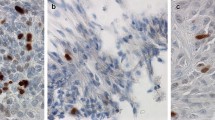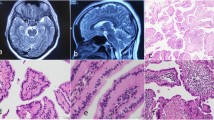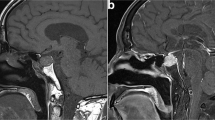Abstract
We describe herein the unique case of a 70-year-old male with a TTF-1-positive non-adenomatous sellar tumor that has unusual morphological and immunohistochemical features. MRI examination detected a 2-cm sellar mass that was enhanced heterogeneously. By histology, the tumor was composed of epithelioid and oncocytic cells arranged in a trabecular pattern with occasional luminal structures. The lesion was diffusely immunopositive for thyroid transcription factor-1 (TTF-1) and vimentin but negative for S100 protein and GFAP. Immunoreactivity for epithelial membrane antigen, low molecular weight cytokeratin (CAM 5.2), and neuronal markers was also observed in the tumor cells. By electron microscopy, the tumor cells were filled with abundant mitochondria and extended microvillous projections into small extracellular and intracellular lumens. TTF-1 is considered to be an excellent marker of pituicytes, specialized glia of the neurohypophysis. This case can be regarded as a variant of pituicytoma, showing both ependymal differentiation and oncocytic changes. However, the immunoprofile was not completely consistent with a pituicyte lineage; the epithelial features suggested a possibility of folliculostellate cell origin. TTF-1-positive sellar neoplasms might therefore have variable morphological and immunohistochemical profiles. For suitable classification of TTF-1 positive sellar neoplasms, their histological features should be carefully re-evaluated.


Similar content being viewed by others
References
Louis DN, Ohgaki H, Wiestler OD et al (2007) The 2007 WHO classification of tumours of the central nervous system. Acta Neuropathol 114:97–109
Roncaroli F, Scheithauer BW, Cenacchi G et al (2002) ‘Spindle cell oncocytoma’ of the adenohypophysis: a tumor of folliculostellate cells? Am J Surg Pathol 26:1048–1055
Inoue K, Couch EF, Takano K et al (1999) The structure and function of folliculo-stellate cells in the anterior pituitary gland. Arch Histol Cytol 62:205–218
Lee EB, Tihan T, Scheithauer BW et al (2009) Thyroid transcription factor 1 expression in sellar tumors: a histogenetic marker? J Neuropathol Exp Neurol 68:482–488
Singh G, Agarwal S, Sharma MC et al (2012) Spindle cell oncocytoma of the adenohypophysis: report of a rare case and review of literature. Clin Neurol Neurosurg 114:267–271
Mete O, Lopes MB, Asa SL (2013) Spindle cell oncocytomas and granular cell tumors of the pituitary are variants of pituicytoma. Am J Surg Pathol 37:1694–1699
Hatton GI (1988) Pituicytes, glia and control of terminal secretion. J Exp Biol 139:67–79
Kowalski RJ, Prayson RA, Mayberg MR (2004) Pituicytoma. Ann Diagn Pathol 8:290–294
Takei Y, Seyama S, Pearl GS et al (1980) Ultrastructural study of the human neurohypophysis. II. Cellular elements of neural parenchyma, the pituicytes. Cell Tissue Res 205:273–287
Saeed Kamil Z, Sinson G, Gucer H et al (2014) TTF-1 expressing sellar neoplasm with ependymal rosettes and oncocytic change: mixed ependymal and oncocytic variant pituicytoma. Endocr Pathol 25:436–438
Scheithauer BW, Swearingen B, Whyte ET et al (2009) Ependymoma of the sella turcica: a variant of pituicytoma. Hum Pathol 40:435–440
Vajtai I, Beck J, Kappeler A et al (2011) Spindle cell oncocytoma of the pituitary gland with follicle-like component: organotypic differentiation to support its origin from folliculo-stellate cells. Acta Neuropathol 122:253–258
Coire CI, Horvath E, Smyth HS et al (2009) Rapidly recurring folliculostellate cell tumor of the adenohypophysis with the morphology of a spindle cell oncocytoma: case report with electron microscopic studies. Clin Neuropathol 28:303–308
Brat DJ, Scheithauer BW, Staugaitis SM et al (2000) Pituicytoma: a distinctive low-grade glioma of the neurohypophysis. Am J Surg Pathol 24:362–368
Kimura S, Hara Y, Pineau T et al (1996) The T/ebp null mouse: thyroid-specific enhancer-binding protein is essential for the organogenesis of the thyroid, lung, ventral forebrain, and pituitary. Genes Dev 10:60–69
Lazzaro D, Price M, de Felice M et al (1991) The transcription factor TTF-1 is expressed at the onset of thyroid and lung morphogenesis and in restricted regions of the foetal brain. Development 113:1093–1104
Coates PJ, Doniach I (1988) Development of folliculo-stellate cells in the human pituitary. Acta Endocrinol (Copenh) 119:16–20
Nakajima T, Yamaguchi H, Takahashi K (1980) S100 protein in folliculostellate cells of the rat pituitary anterior lobe. Brain Res 191:523–531
Yamashita M, Qian ZR, Sano T et al (2005) Immunohistochemical study on so-called follicular cells and folliculostellate cells in the human adenohypophysis. Pathol Int 55:244–247
Horvath E, Coire CI, Kovacs K et al (2010) Folliculo-stellate cells of the human pituitary as adult stem cells: examples of their neoplastic potential. Ultrastruct Pathol 34:133–139
Acknowledgments
The authors are grateful to Prof. Sylvia L. Asa, MD, Ph.D, and Dr. Ozgur Mete, MD, of the Department of Laboratory Medicine and Pathobiology, University of Toronto, for their comments on this case. We thank Dr. M Ruberg, Ph.D, for a critical reviewing of the manuscript, Ms. Harumi Masuda for excellent technical assistance with the immunohistochemical staining, and Mr. Masanori Suzuki for preparation of the electron microscopy images.
Conflict of interest
The authors declare no conflict of interest.
Author information
Authors and Affiliations
Corresponding author
Rights and permissions
About this article
Cite this article
Yoshimoto, T., Takahashi-Fujigasaki, J., Inoshita, N. et al. TTF-1-positive oncocytic sellar tumor with follicle formation/ependymal differentiation: non-adenomatous tumor capable of two different interpretations as a pituicytoma or a spindle cell oncocytoma. Brain Tumor Pathol 32, 221–227 (2015). https://doi.org/10.1007/s10014-015-0219-3
Received:
Accepted:
Published:
Issue Date:
DOI: https://doi.org/10.1007/s10014-015-0219-3




